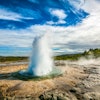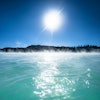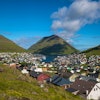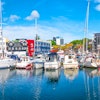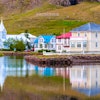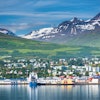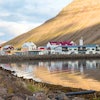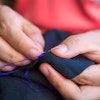Filter Holidays
Find your
next holiday
Filter
Holidays
Sign Up to Emails
Subscribe to our email newsletter and find out the latest news, updates and offers first!
Iceland and Faroes Stitching Cruise
Itinerary
Please choose your preferred 13 day itinerary
Meet Karin Hellaby and your tour manager at Liverpool port where you will board Fred Olsen Cruise Line’s Bolette. This evening, we depart from Liverpool and enjoy sailing towards Iceland.
Included Meals
- Dinner
We continue to make our way to Iceland. On Bolette, make the most of the wonderful programme of events and activities as well as stitching workshops with Karin.
Included Meals
- Breakfast
- Lunch
- Dinner
Highlights
- Workshops
Enjoy the morning at sea and work on your projects with Karin. This afternoon we will arrive in Reykjavik, the world’s most northerly capital. Our included excursion this afternoon is to the iconic Blue Lagoon. Surrounded by a mossy green lava field, the Blue Lagoon geothermal spa is a truly otherworldly experience. The lagoon has a floor covered in silica mud, which is incredibly healing and soothing for the skin. What was originally a pool of wastewater from a geothermal plant, soon became a national hit as Icelanders started bathing in the water and applying the wholesome mud. Now a luxurious spa, the Blue Lagoon is a glorious destination that still retains its beautiful natural atmosphere and surroundings.
Included Meals
- Breakfast
- Lunch
- Dinner
Highlights
- Blue Lagoon
- Workshop
Our included excursion today is to the Golden Circle, the most famous of all the scenic routes in Iceland. Stops include Geysir Geothermal Park boasting spouting springs, including Strokkur, the most active geyser in Iceland, Gullfoss Waterfall, Iceland’s most famous waterfall, and Thingvellir National Park, a UNESCO World Heritage Site.
Included Meals
- Breakfast
- Lunch
- Dinner
Highlights
- The Golden Circle
Early this morning we arrive into Ísafjörður. Located on the peninsular of the Westfjords, with a backdrop of steep mountains, this area has been one of Iceland’s most popular fishing and trading centres for over two centuries. The area surrounding Ísafjörður is the most rural in Iceland, with many secluded valleys that are home to historic and isolated farms. We depart Ísafjörður late afternoon and enjoy the rest of the day at sea. Hornbjarg is renowned for its spectacular natural beauty and remoteness. The area is a combination of vast tundra, sheer cliffs and flowering fields. Established as a nature reserve in 1975, it’s one of the best places to observe the rich wildlife and flourishing nature. There are about 260 different species of flowering plants and ferns that grow here, many of these are native to the Westfjords, and some unique to Hornbjarg. The incredible midnight sun can be seen during the summer months at the northernmost point on Grimsey Island, a tiny island home to millions of seabirds including Arctic terns and puffins.
Included Meals
- Breakfast
- Lunch
- Dinner
Highlights
- Ísafjörður
This morning we sail into Akureyri. Located at the end of the Eyjafjordur, Iceland’s longest fjord, the waters around the fjord and coastline offer one of the best feeding grounds in the world for cetaceans, particularly humpback whales. Later this afternoon we enjoy scenic sailing, cruising through the magnificent Eyjafjörður and by Hrísey Island, known as the ‘Pearl of the Eyjafjordur’. This is Iceland’s second largest island, yet only around 200 people live here in one tiny fishing village. Those who do live on Hrisey share the flat green lands of the island with more than 40 bird species, including ptarmigans and the largest breeding colony of Arctic terns.
Included Meals
- Breakfast
- Lunch
- Dinner
Highlights
- Akureyri
Renowned for its natural beauty, Borgarfjörður Eystri, located in the east of Iceland, is set amongst vast mountains and deep grassy valleys. It is an excellent spot for birdwatching and is considered to be one of the best places to see puffins. We arrive into Seyðisfjörður, regarded as one of Iceland’s most picturesque towns, surrounded by valleys where 25 waterfalls cascade down into the lagoon at the head of the fjord. Skalanes Nature Reserve is situated on the south side of the town and many seabirds, such as the black tailed godwit, and cetaceans, including seal and porpoise, can be found here.
Included Meals
- Breakfast
- Lunch
- Dinner
Highlights
- Seyðisfjörður
The Faroe Islands, which translate to “Sheep Islands” was a name given by the Norse during the Viking Age, and Tórshavn is the capital city of these islands. Sheep farmers are well established here and produce wool to be made into clothing using traditional methods. Our included excursion will take us to the cultural centre of Kirkjubour, the southernmost village on Streymoy Island and the Faroes’ most historical site. Here we’ll visit the museum, St. Olav’s Church and the ruins of St. Magnus Cathedral. We return to Torshavn to visit the National Museum, where we’ll learn about the geology, botany, zoology, archaeology, folk-life and history of the Faroe Islands. Among the cultural treasures in the exhibition, we'll see the original Faroese rowing boat, traditional Faroese clothes and interesting findings from the Viking era. You can also experience a journey through the natural and geological history of the Faroe Islands with its mammal and bird life and the volcanic geological origin of the islands. Our final stop will be at the art gallery, where we can view some local artwork whilst enjoying coffee and cake.
Included Meals
- Breakfast
- Lunch
- Dinner
Highlights
- Tórshavn
The Faroese islets of Gáshólmur and Tindhólmur are collections of rugged islands and intriguing rock formations to marvel at, due to the diversity of the natural wonders on display. The iconic Drangarnir ‘rock with the hole’, one of the Faroe Islands’ most famous and photographed landmarks, is close by. Scenic cruising by Gásadalur (Goose Valley) is a chance to see one of the Faroe Islands’ most famous and photographed scenes. As we sail slowly by, we'll look out for the tiny village perched on top of a tall cliff overlooking the Atlantic Ocean. Mykines is the westernmost of all the Faroe Islands and is popular with birdwatchers due to the plethora of nesting seabirds which perch along the shore, such as gannets, puffins, Arctic terns, razorbills and guillemots. The imposing Vestmanna Cliffs, or Vestmannabjørgini as they're known locally, are one of the Faroe Island's most famous sights, with its naturally formed jagged peaks and sheer-drop cliff faces of grass-smothered rock formations. During the summer months, it may be possible to spot a number of bird colonies of varying species, such as puffins, guillemots, fulmars and kittiwakes. Cape Enniberg is located on the island of Viðoy. Standing at over 750 metres high, it is one of the highest vertical sea cliffs in the world and are home to a huge number of seabird colonies - in particular, puffins and fulmars - who perch on its craggy rock faces. This evening we will arrive into Klaksvík, located on the island of Bordoy.
Included Meals
- Breakfast
- Lunch
- Dinner
Located on the island of Borðoy, Klaksvík is the Faroe Islands' second largest town and, thanks to the backdrop of rolling hills and craggy cliffs, one of its most beautiful. This unique town, with its Christianskirkjan Church, traditional farms and busy port, is considered the cultural and commercial hub of the Faroes. Our included excursion will take us around Lake Toftir, the fourth largest natural lake in the islands, where we’ll visit a sheep croft. We continue to Navia, which produces and sells yarn. Sweaters and knitting patterns. Founded as part of a business school project, Navia began as a small company but today is one of the leading companies in not only the Faroes but also overseas.
Our return journey will take us through the sub-sea tunnel of Eysturoy and along the coast. Once back at Klaksvík, we can enjoy the fine architecture of the Christianskirkjan Church before returning to the ship.
Included Meals
- Breakfast
- Lunch
- Dinner
Highlights
- Klaksvík
A final day of scenic sailing as we journey back to Liverpool.
Included Meals
- Breakfast
- Lunch
- Dinner
Arrive back into Liverpool in the early morning.
Included Meals
- Breakfast
Accommodation
You will stay for twelve nights onboard Fred Olsen's Bolette in your chosen cabin, equipped with climate control, interactive smart TV, hairdryer, desk, phone, fridge and tea and coffee-making facilities.



